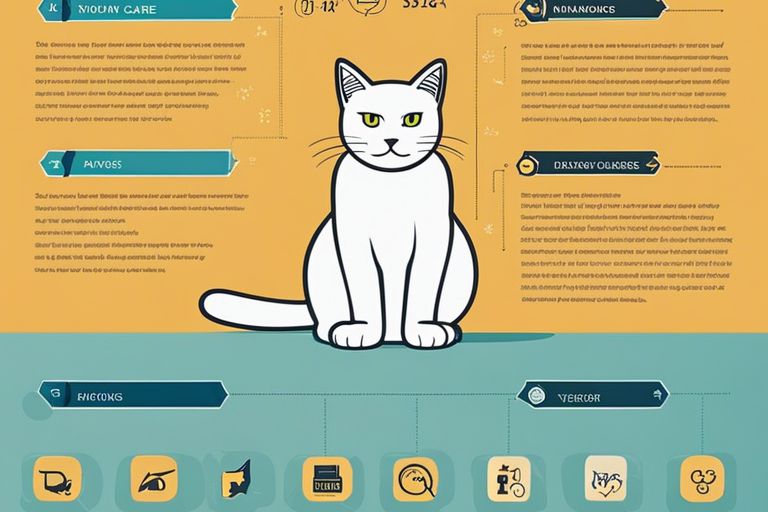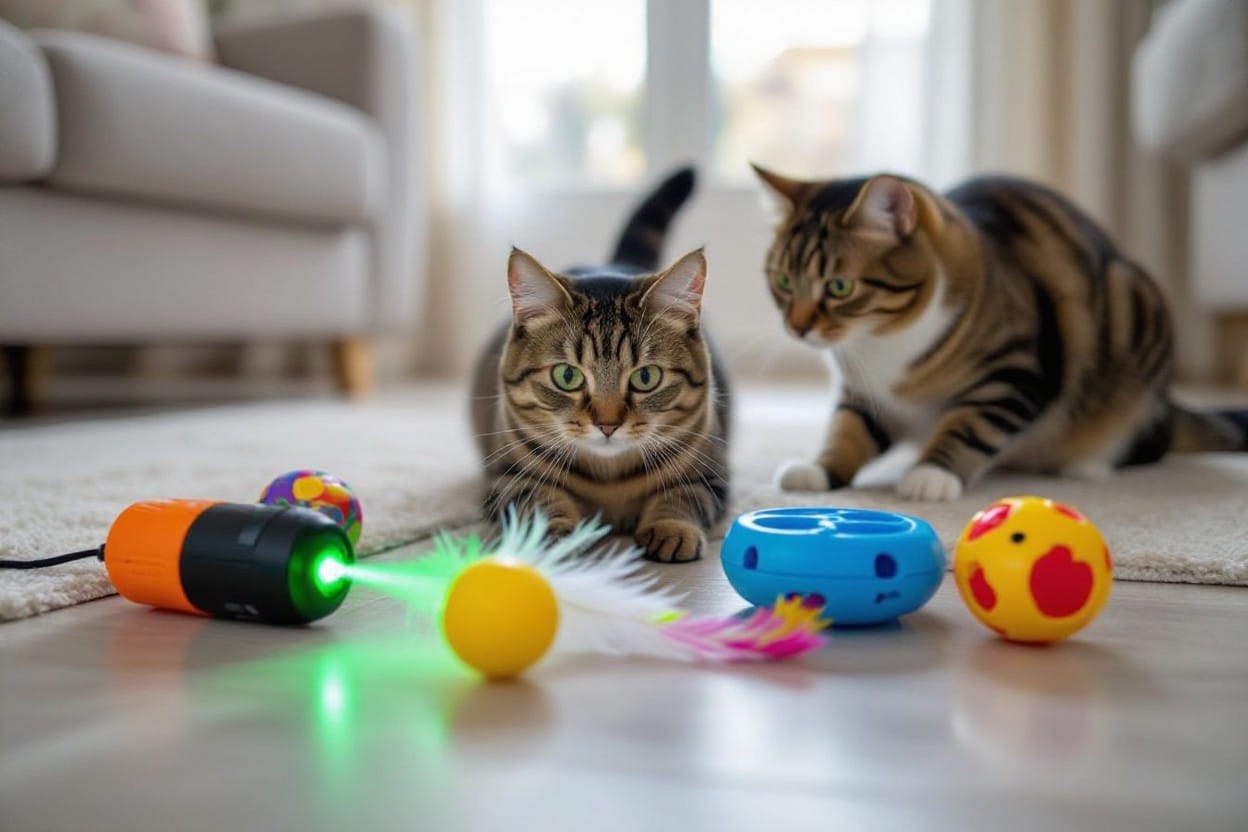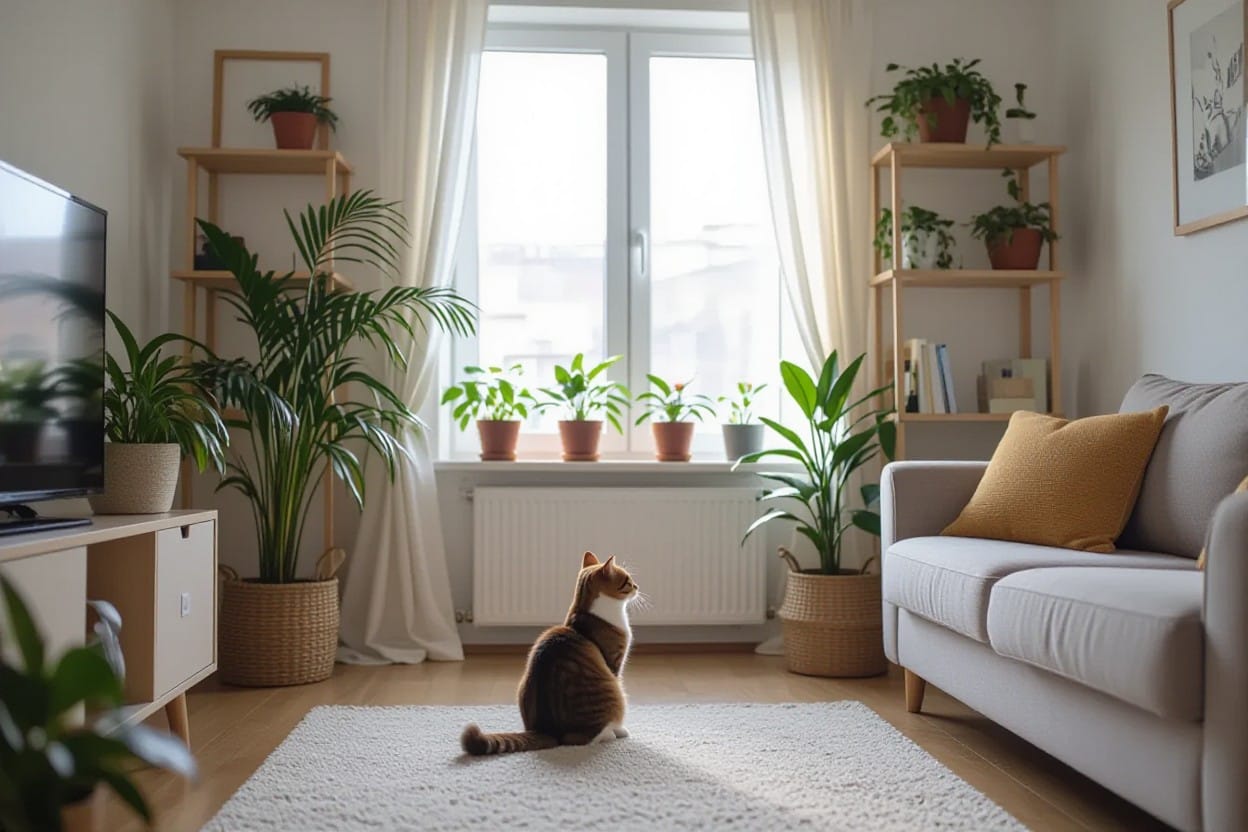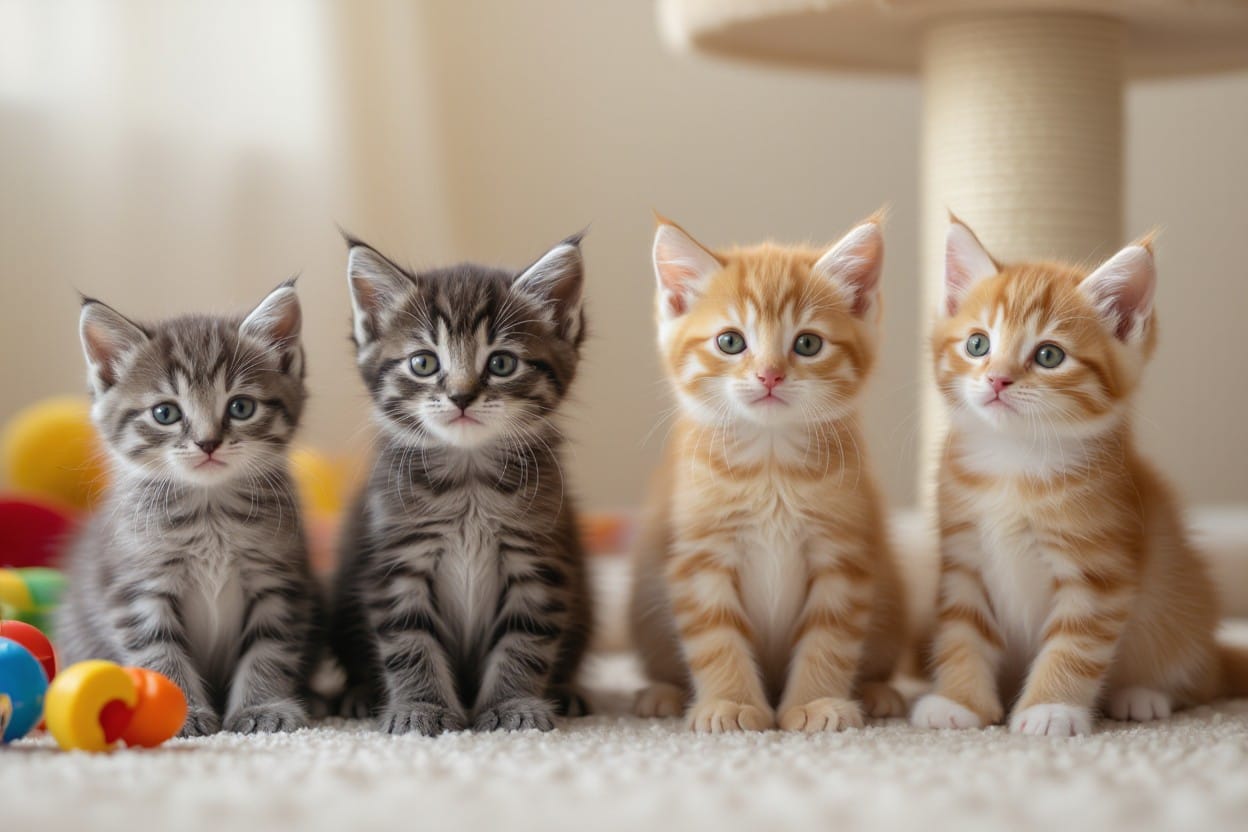Many cat owners can attest to the mysterious and sometimes puzzling behaviors exhibited by their feline companions. Understanding your cat’s body language and behaviors is crucial in developing a strong bond and communication with your pet. Cats communicate primarily through their body language, using a combination of vocalizations, facial expressions, and physical gestures to convey their emotions and needs.
By familiarizing yourself with common cat behaviors and cues, you can better interpret your cat’s signals and respond appropriately. This knowledge can help strengthen the relationship between you and your cat, leading to a happier and more harmonious household. In this blog post, we will explore some key elements of feline body language and behaviors to help you better understand and connect with your beloved pet.
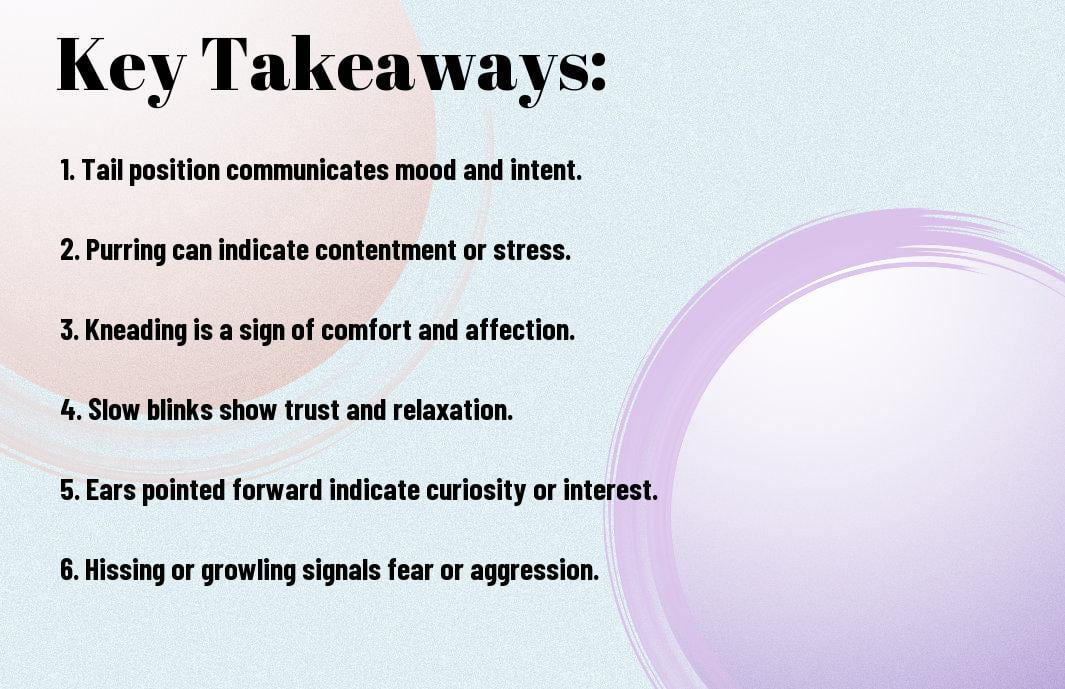
The Basics of Feline Communication
Little is more fascinating than delving into the intricate world of feline communication. Cats have a rich repertoire of behaviors and signals that they utilize to convey their feelings and intentions. Understanding these cues is important for developing a strong bond with your furry companion.
Understanding the Natural Behaviors of Cats
With a history deeply rooted in being both predator and prey, cats have a unique set of behaviors that dictate their interactions. From the way they stalk their toys to how they groom themselves meticulously, each action serves a purpose in their world. Observing these behaviors can provide valuable insights into your cat’s mood and needs.
The Role of Scent, Sound, and Body Posture
Behaviors such as scent marking, vocalizations, and body posture play a crucial role in feline communication. Cats use scent to mark their territory and familiarize themselves with their environment. Sound, including purring, meowing, and hissing, helps them express a wide range of emotions. Additionally, body posture, such as flattened ears or a raised tail, can indicate feelings of fear, aggression, or contentment.
Cats are masters of non-verbal communication, employing a combination of scent, sound, and body language to convey their thoughts and emotions. Being attuned to these signals can significantly enhance your relationship with your cat and ensure a harmonious coexistence.
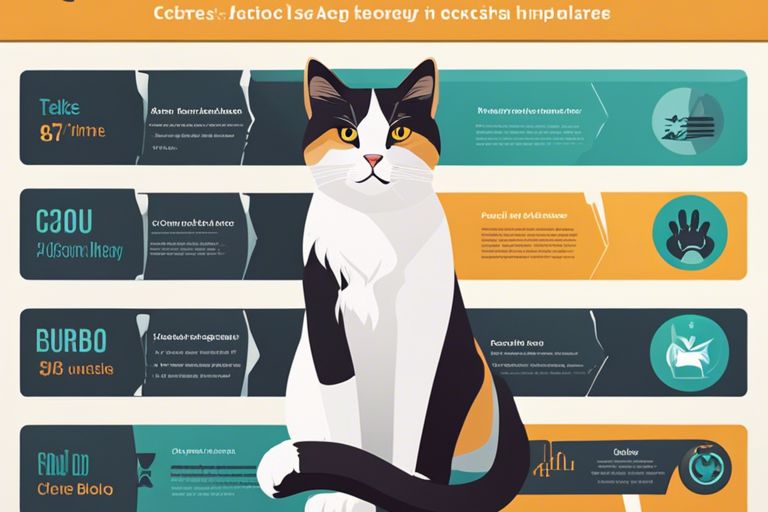
Decoding Facial Expressions
The Eyes: Dilated Pupils and Slow Blinking
Any cat owner knows that a cat’s eyes can reveal a lot about their mood. Dilated pupils often indicate excitement, fear, or aggression, while constricted pupils suggest contentment or tension. On the other hand, slow blinking is a sign of trust and affection in the feline world. When your cat gives you a slow blink, they are importantly saying, “I feel safe and comfortable around you.”
The Ears: Swiveling and Flattening
Any experienced cat parent understands the importance of paying attention to their cat’s ears. When a cat’s ears are swiveled forward, it usually indicates curiosity or interest. Conversely, flattened ears signal fear, aggression, or discomfort. Understanding these subtle cues can help you gauge your cat’s emotional state and respond accordingly.
The position of a cat’s ears can provide valuable insights into their feelings and intentions. Cats are masters of non-verbal communication, and their ears play a significant role in expressing their emotions.
The Whiskers: Forward and Backward Positions
With their impressive whiskers, cats also communicate through these sensitive facial features. When a cat’s whiskers are pointed forward, it typically signifies that they are feeling curious or excited. Conversely, whiskers drawn backward indicate fear, anxiety, or aggression. Observing the position of your cat’s whiskers can help you understand how they are feeling in different situations.
Expressions can help you decipher your cat’s mood and respond appropriately. Paying attention to these subtle cues can strengthen your bond with your feline companion and ensure their well-being.
The Mouth: Yawns, Hisses, and Chattering
Dilated pupils and hissing are common facial expressions that can signal a range of emotions in cats. Yawning can indicate relaxation or anxiety, while hissing is a clear sign of fear or aggression. Additionally, chattering, where a cat makes rapid jaw movements without vocalizing, is often seen when they are feeling excited or frustrated. Understanding these mouth expressions can give you valuable insights into your cat’s state of mind.
Flattening of the mouth, such as lip smacking or pulling back their lips, can indicate discomfort or irritation. It’s important to observe your cat’s mouth expressions in conjunction with other body language cues to get a complete picture of their feelings and needs.
Vocalizations and What They Mean
Meowing: From Requests to Greetings
They say that cats don’t meow at each other in the wild—this sound is reserved for their interactions with humans. Your cat’s meow can vary in tone and pitch, signaling different needs or emotions. A short, sharp meow may indicate a request for food or attention, while a long, plaintive meow could signify loneliness or discomfort. Cats may also greet their favorite humans with a soft, gentle meow as a form of communication and bonding.
Purring: Contentment and Other Meanings
Vocalizations such as purring can be a bit more mysterious in their meaning. Cats commonly purr when they are content, such as when they are being petted or are relaxing in a sunny spot. However, cats may also purr when they are in pain or distress, as a self-soothing mechanism. It’s important to pay attention to your cat’s body language and other vocalizations to interpret the context of their purring.
What your cat is trying to communicate through its vocalizations can provide valuable insights into its emotional state and needs. Understanding the various sounds that your cat makes can help strengthen your bond and ensure a harmonious relationship.
Hissing and Growling: Expressing Discomfort or Threat
What do you do when your cat hisses or growls? These vocalizations are clear signs of discomfort, fear, or perceived threat. Cats may hiss and growl when they feel cornered, threatened by another animal, or scared. It’s vital to give your cat space and time to calm down in these situations and to try to identify the source of their distress.
It’s crucial not to force interactions or escalate the situation when your cat is hissing or growling, as it can lead to defensive behavior or aggression. Give your cat the opportunity to retreat to a safe place and approach them calmly and gently once they have calmed down.
Chirps and Trills: Communicating with Kittens and Humans
Trills and chirps are delightful vocalizations that cats use to communicate with kittens, other cats, and even their human companions. These sounds are often friendly and inviting, indicating a desire for interaction or play. Cats may also use chirps and trills to get your attention or to express excitement or happiness.
With a bit of practice and observation, you can learn to decipher your cat’s various vocalizations and respond accordingly, building a stronger connection and fostering a deeper understanding of your feline friend.
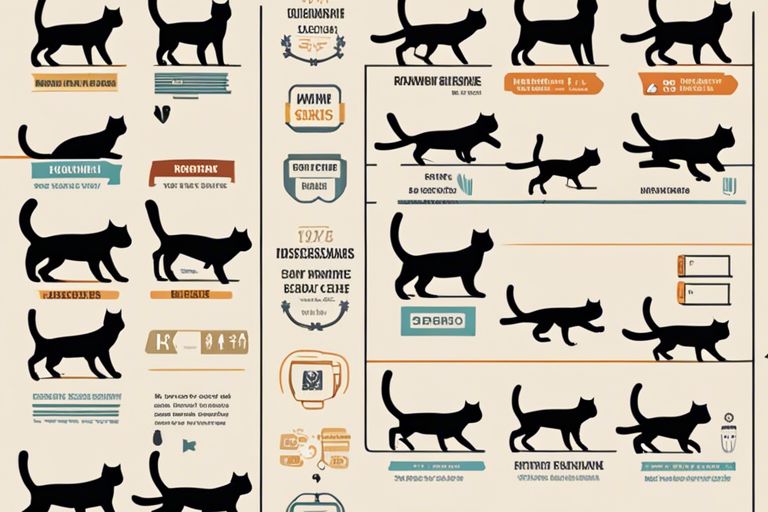
The Tail: A Barometer of Moods
All cat owners know that a cat’s tail can speak volumes about their mood. From confidence to fear, the tail can be a clear indicator of what your feline friend is feeling. Understanding the various tail positions and movements can help you better communicate with your cat and provide the appropriate support.
High and Curved: Confidence and Happiness
Happiness is reflected in a cat’s tail that is held high and curved at the tip. This position signals contentment and confidence in their surroundings. When your cat greets you with a raised, curved tail, it means they are happy to see you and are comfortable in your presence. This is a positive indication of your cat’s well-being and their overall enjoyment of the moment.
Low and Tucked: Fear and Submission
The low and tucked tail position is a clear sign of fear or submission in cats. When a cat tucks their tail tightly between their hind legs, it indicates that they are feeling scared or anxious. This behavior is often accompanied by other signs of distress, such as flattened ears or dilated pupils. It’s crucial to create a safe and calm environment for your cat to help alleviate their fear and anxiety.
The position of a cat’s tail can provide valuable insights into their emotional state and help you respond appropriately to their needs. By recognizing the different tail positions and behaviors, you can better understand and support your feline companion.
Body Postures and Movements
Many cat behaviors can be easily understood by paying close attention to their body postures and movements. These non-verbal cues are vital in deciphering what your feline friend might be trying to communicate. By learning to interpret these signs, you can better understand your cat’s moods and needs.
The Arching Back: A Defensive Stance
With their back arched, fur puffed up, and tail bristled, a cat is displaying a defensive posture. This behavior is often seen when a cat feels threatened or scared. By arching their back, they are trying to appear larger and more intimidating to potential threats.
Kneading: A Sign of Affection and Contentment
With a rhythmic motion of pushing in and out with their paws, kneading is a behavior commonly associated with feelings of comfort and security. This instinctual behavior stems from kittenhood when nursing from their mother. Cats often knead when they are feeling content and happy.
Back arching, belly exposure, rolling, and rubbing are all forms of cat behaviors that are crucial in understanding your feline companion’s emotions and needs. By observing these body postures and movements, you can better communicate with your cat and build a stronger bond based on trust and understanding.
Belly Exposure: Trust or a Potential Trap
Defensive cats may roll onto their back and show their belly as a defensive tactic. While some cats enjoy belly rubs and see this as a sign of trust, others may view it as a vulnerable position. It’s necessary to pay attention to your cat’s overall body language to determine whether belly exposure is an invitation for affection or a warning sign.
Arching their back may also indicate a defensive stance in cats. When a cat feels threatened or anxious, they may arch their back to appear more substantial and more intimidating to potential threats. Understanding this behavior can help you navigate interactions with your cat more effectively.
Rolling and Rubbing: Marking and Social Bonding
Back rolling and rubbing against objects or humans are behaviors that serve as a way for cats to mark their territory and bond socially. By leaving their scent on objects and people, cats establish a sense of familiarity and ownership in their environment. These actions also serve as a way for cats to communicate with other animals and humans in their surroundings.
Rubbing their head against you or furniture is a natural behavior that allows cats to mark their territory with scent glands located on their face. By engaging in this behavior, cats are not only marking their territory but also expressing comfort and affection towards you. Understanding these actions can deepen the bond between you and your feline companion.
Interpreting Play, Hunting, and Grooming Behaviors
Play Behavior: Practice for Survival
To understand your cat’s behavior, it’s important to recognize that play is not just about fun and games—it serves a vital purpose in your cat’s development. Play behavior in cats mimics hunting skills and helps them practice important survival techniques. Whether they are pouncing on a toy mouse or chasing a feather wand, your cat’s playtime is a way for them to hone their hunting instincts and stay agile.
Hunting Instincts: The Stalk and Pounce
Instincts drive a large part of your cat’s behavior, especially when it comes to hunting. The stalk and pounce are natural behaviors that stem from your cat’s ancestry as predators. When your cat crouches low, wiggles their hind end, and then leaps forward to catch prey (or a toy), they are exhibiting this classic hunting sequence.
This instinctual behavior is deeply ingrained in your cat’s DNA, and even though they may no longer need to hunt for food, the thrill of the chase is still very much a part of who they are.
Grooming: Hygiene and Social Interaction
Interpreting your cat’s grooming habits can give you valuable insights into their well-being and social interactions. Grooming is not just about cleanliness; it is also a way for cats to maintain their fur, keep cool, and show affection. When your cat grooms itself, it is a sign that they feel comfortable and secure in their environment.
Hunting and grooming behaviors are deeply rooted in your cat’s natural instincts and are important for their physical and emotional well-being. Understanding these behaviors can help you better communicate with your feline companion and provide them with the care and enrichment they need to thrive.
Common Misunderstandings and Misinterpretations
Your cat’s body language can sometimes be confusing, leading to common misunderstandings and misinterpretations. It’s necessary to learn how to accurately read your feline friend’s cues to understand their state of mind and needs.
Assessing Mixed Signals
Mixed signals from your cat, such as purring while showing signs of aggression or fear, can be perplexing. In these cases, it’s crucial to look at the overall context and body language of your cat to make an accurate assessment. Pay attention to their ears, tail, and overall posture to get a better understanding of their feelings.
Cat Behavior Myths Debunked
The world of cat behavior is often clouded by myths and misconceptions. Cats are not vindictive or aloof by nature, contrary to popular belief. Understanding the true nature of your cat can help improve your relationship and communication with them.
Plus, knowing the truth behind common cat behavior myths can prevent misunderstandings and help you provide the best care for your feline companion. Educating yourself on feline behavior will lead to a more harmonious and fulfilling relationship with your cat.
When to Worry: Signs of Stress or Illness
Behavioral changes in your cat can sometimes signal underlying stress or illness. It’s necessary to monitor your cat’s behavior closely and look for signs such as excessive hiding, changes in appetite, or aggression. If you notice any concerning behavior, it’s crucial to consult with your veterinarian to rule out potential health issues.
To ensure your cat’s well-being, it’s important to address any signs of stress or illness promptly. By understanding your cat’s typical behaviors and monitoring any changes, you can provide them with the care and support they need to stay happy and healthy.
Enhancing Your Connection with Your Cat
Once again, fostering a strong bond with your cat is vital for a fulfilling and harmonious relationship. Understanding and responding appropriately to your cat’s signals will help you communicate effectively and build trust with your feline companion.
Responding Appropriately to Your Cat’s Signals
One key aspect of enhancing your connection with your cat is being attuned to their body language and behaviors. Cats communicate through a variety of signals, such as vocalizations, tail movements, and eye contact. By observing and interpreting these cues, you can better understand your cat’s feelings and respond accordingly to strengthen your bond.
Tips for Bonding and Building Trust
- Create a safe and comfortable environment for your cat to feel secure.
- Spend quality time engaging in interactive play sessions to build a positive association with you.
Cats thrive on routines and are highly sensitive to changes in their environment. By providing a consistent and loving atmosphere, you can help your cat feel more relaxed and bonded with you. Perceiving and responding to their needs with empathy and patience will foster a deeper connection over time.
Training and Encouraging Positive Behaviors
Positive reinforcement is key to shaping your cat’s behavior and building a strong bond. Cats respond well to rewards such as treats, praise, and playtime when they exhibit desirable behaviors. By using positive reinforcement techniques, you can encourage your cat to engage in positive behaviors and strengthen your bond through teamwork.
With consistent training and positive reinforcement, you can help your cat develop good habits and strengthen your bond through shared experiences.
Summing up
Hence, it is important for cat owners to educate themselves on their cat’s body language and behaviors to better understand their needs and emotions. By paying attention to signs like tail position, ear movement, vocalizations, and body posture, cat owners can develop a deeper connection with their feline companions and provide them with the care and support they require. Understanding these cues can help prevent misunderstandings and strengthen the bond between cats and their owners.
FAQ
Q: How can I understand my cat’s body language?
A: To understand your cat’s body language, pay attention to signs like tail position, ear movements, and vocalizations. A cat with an upright tail and relaxed ears is usually content, while a cat with a lowered tail and twitching ears may be agitated or fearful.
Q: What does it mean when my cat purrs?
A: Cats purr for various reasons, including contentment, relaxation, and sometimes to self-soothe. However, cats may also purr when they are in pain or distress, so it’s important to consider the context in which your cat is purring.
Q: Why does my cat knead me with their paws?
A: Kneading, where a cat rhythmically presses and relaxes their paws against a surface (often their owner), is a behavior cats display from kittenhood when nursing. Cats may knead to show affection, mark their territory with scent glands on their paws, or simply as a comforting behavior.
Q: What does it mean when my cat’s tail is puffed up?
A: A puffed-up tail typically indicates that a cat is frightened, startled, or feeling threatened. This defensive posture makes the cat appear larger to potential threats and is a sign that your cat is in distress.
Q: How can I tell if my cat is happy?
A: A happy cat will exhibit relaxed body language, such as gently blinking or slow blinking at you, a relaxed posture, and content vocalizations like chirps or trills. They may also approach you for attention or affection. By observing your cat’s overall behavior and body language, you can gauge their emotional state and ensure they are happy and healthy.
